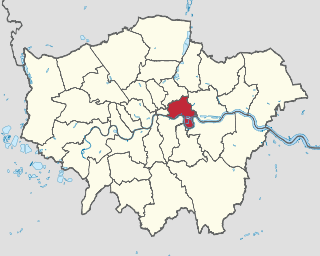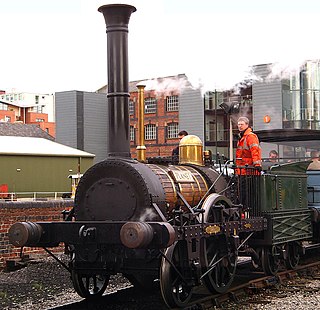Bow railway works was at Bow, an area of London, England, in the London Borough of Tower Hamlets. It was built in 1853 by the North London Railway.

London is the capital and largest city of both England and the United Kingdom. Standing on the River Thames in the south-east of England, at the head of its 50-mile (80 km) estuary leading to the North Sea, London has been a major settlement for two millennia. Londinium was founded by the Romans. The City of London, London's ancient core − an area of just 1.12 square miles (2.9 km2) and colloquially known as the Square Mile − retains boundaries that follow closely its medieval limits. The City of Westminster is also an Inner London borough holding city status. Greater London is governed by the Mayor of London and the London Assembly.

Tower Hamlets is located in East London and covers much of the traditional East End.
The North London Railway (NLR) company had lines connecting the north of London to the East and West India Docks in the east of the city. The main east to west route is now part of London Overground's North London Line. Other NLR lines fell into disuse but were later revived as part of the Docklands Light Railway, and the Overground's East London Line. The company was originally called the East & West India Docks & Birmingham Junction Railway (E&WID&BJR) from its inception in 1850, until 1853. It ceased operations in 1922.
Contents
Bow railway works was built by the North London Railway in 1853 on a 10-acre (40,000 m2) site which also included a sizeable wagon repair shop, under the direction of William Adams the locomotive superintendent. At first it was used for the repair of locomotives purchased from outside contractors, but from 1860 it was enlarged to enable it to undertake locomotive construction. The first locomotive completed was 4-4-0T No. 43 which incorporated the Adams bogie, to improve high-speed stability. The last steam locomotive to be built at Bow was 4-4-0T No. 4 in 1906. [1]

William Adams was an English railway engineer. He was the Locomotive Superintendent of the North London Railway from 1858 to 1873; the Great Eastern Railway from 1873 until 1878 and the London and South Western Railway from then until his retirement in 1895. He is best known for his locomotives featuring the Adams bogie, a device with lateral centring springs to improve high-speed stability. He should not be mistaken for William Bridges Adams (1797–1872) a locomotive engineer who, confusingly, invented the Adams axle – a radial axle that William Adams incorporated in designs for the London and South Western Railway.

Under the Whyte notation for the classification of steam locomotives by wheel arrangement, 4-4-0 represents the arrangement of four leading wheels on two axles, usually in a leading bogie, four powered and coupled driving wheels on two axles, and no trailing wheels. Almost every major railroad that operated in North America in the first half of the 19th century owned and operated locomotives of this type. Due to the large number of the type that were produced and used in the United States, the 4-4-0 is most commonly known as the American type, but the type subsequently also became popular in the United Kingdom, where large numbers were produced.
A new erecting shop was built in 1882 under Adams' successor J.C. Park, who continued producing 4-4-0 and 0-6-0 tank engines for the railway. At its height the workshops were employing 750 men. Between 1879 and 1901, thirty 0-6-0 tanks designed by J.C.Park were built, of which fourteen lasted until British Railways ownership, the last being taken out of service in 1958 some seventy years old. [2]

Under the Whyte notation for the classification of steam locomotives, 0-6-0 represents the wheel arrangement of no leading wheels, six powered and coupled driving wheels on three axles and no trailing wheels. This was the most common wheel arrangement used on both tender and tank locomotives in versions with both inside and outside cylinders.



















